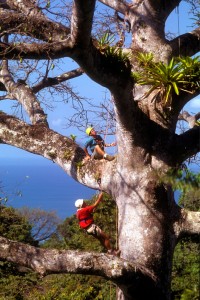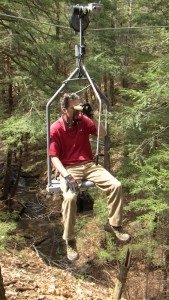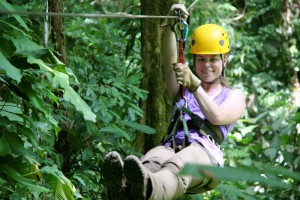Exploring the Rainforest Canopy

By Jack Ewing
Everyone I know who has ever crossed a river on one of those old cable cars has gotten their fingers pinched at least once. Years ago this was the only way to cross some of the major rivers in rural Costa Rica. There was one over the Guabo river at Barú before the bridge was built in the early 60s, and I have ridden in the one that used to span the Savegre River at Santo Domingo. Up until about 2010 a cable was stretched across the river there with a platform hanging from it on a couple of pulleys. In Costa Rica this type of cable crossing is called an “andarivel”. Everybody knew that the carrying capacity of the one at Santo Domingo was two passengers, but people often overloaded it anyway. In order to make the platform move along the cable it was necessary for the passenger to pull on the cable. Since the only place to pull was between the two pulleys people often got their fingers caught in the second pulley. I can testify to this from personal experience. The andarivel at Santo Domingo was replaced with a suspension bridge about five years ago. There is still a functioning andarivel on the Savegre river between Silencio and Santo Domingo. I jokingly say that the andarivels were Costa Rica’s first zip lines.


Biologists have long been interested in the rainforest canopy. The first tools used for its exploration were telescoping poles with a pruning shearer or a saw blade on the end. With this they would cut a branch, which would then fall to the ground. The scientist could study what little life he/she found there. Needless to say, this method didn’t yield a great deal of data about the biology of the canopy.
One group of biologists in Brazil hired a helicopter and lowered a 40 man rubber raft into the the top of an enormous rainforest tree. They then lowered themselves into the raft where they planned to live for an extended period of time while studying the canopy. This daring and ambitious venture was rather short lived. After only a few days the raft started leaking, and biologists had to call in the helicopter for an emergency evacuation.
In his excellent book Life Above the Forest Floor, Donald Perry Ph D. Tells how he became entranced with the rainforest canopy when he was a university student studying biology. There was virtually nothing known about the canopy at that time, and he decided to dedicate his life to changing that situation. Due to his vast powers of innovation and persistent efforts the canopy is now easily accessible to everyone from biologists to tree huggers and fun loving tourists.

In the book Don Perry describes his first ascent into the rainforest canopy in Corcovado National Park in southern Costa Rica. He used a crossbow to shoot an arrow with a fishing line tied to it into the canopy and over a stout branch. The arrow fell back to earth with the fishing line still attached. The line was then used to pull a rock climbing rope (8000 lbs. test strength) over the branch and back to the ground where it was tied to the base of a nearby tree. Don then climbed the free end of the rope using devices called jumar ascenders, a common piece of gear used by rock climbers. When it was time to rappel back to earth he used a another item used by rock climbers called a breaker bar. Today he uses a figure 8 which is much safer.
The rainforest canopy turned out to be every bit as fascinating as he had expected, and Donald Perry found himself spending as much time in the treetops as on the ground. He decided that he was wasting too much time climbing and descending. What was needed was a system that would allow him to get from one tree to another without returning to the forest floor. This he accomplished by securing climbing ropes from one treetop to another. He then used pulleys to move along the ropes between trees. His first such rope system was built at La Selva Biological Research Center. Later another was set up at Rara Avis nature reserve. Both of these rope courses attracted a great deal of attention and, among other things, inspired that all time great motion picture Medicine Man starring Sean Connery, first released in 1992. Donald Perry was a consultant for the movie.
Perry’s work also inspired the building of recreational rope systems for tourism. The first zip lines in Costa Rica were relatively short and made with ropes. A company called The Original Canopy Tour built one in Monteverde and later another in Orotina at a place called Iguana Park. The Original Canopy Tour was also the first to make zip lines with cables rather than ropes. This was approximately in 1992. Right from the start these zip line tours were all about adrenaline, and there was little or no interest in ecology. They were built in the rainforest because of the abundance of large trees, and it is a lot less expensive to attach the cables to trees than build towers for them.

Donald Perry’s work and the success of the early zip lines gave birth to an idea that would make the rainforest canopy accessible to the general public. It was called the Aerial Tram. The first one, built in Braulio Carrilio National Park, was inaugurated in 1994. This a super version of the old andarivels. Each car seats a maximum of 9 people as it moves through the rainforest canopy. The cars are controlled remotely and the passengers can’t stop the car if they see something interesting. Unlike the zip lines, the trams can definitely be classified as ecological tourism. The Aerial Trams have been quite successful and there are now 4 or 5 of them in Costa Rica.
In 1993 we at Hacienda Baru realized that the rainforest canopy was a new frontier in tropical biology, and we wanted to be a part of it. Donald Perry trained our first guides in the art of tree climbing. One of our guides, a former Peace Corp volunteer named Jim Zook, had extensive experience in rock climbing and quickly learned to adapt the techniques he already knew so well to tree climbing. On top of everything else he was an ornithologist and found the canopy to be an excellent place to pursue his passion for birds. We started offering tree climbing as a tour that same year. The first tree we climbed was an enormous ceiba. The tour was totally oriented towards ecology, but when you are upwards of 30 meters in the crown of an enormous tree the adrenaline is going to flow regardless of whether or not that is the reason you climbed up there.
We soon discovered that there were lots of visitors who would love to experience the rainforest canopy, but who were physically unable to climb a rope, or just didn’t want to work that hard. We solved the problem by building a platform at 32 meters above the forest floor and hoisting people up there with an electric winch. After a time on the platform the people rappelled back down. This was our most popular tour for six years. Then we built a zip line.
We call our zip line the Flight of the Toucan because it mimics the flight of the colorful, big beaked, rainforest birds. This may be the only zip line tour out of 100 to 150 that exist in Costa Rica that wouldn’t be classified as an adrenaline tour. It includes a 40 minute ecological hike up to the first cable, and the entire tour is oriented around ecology. The guides carry telescopes to show people wildlife up close,and love to teach visitors about the fascinating world of the rainforest. The cables are all less than 100 meters long, and aren’t particularly fast. We have taken people from three years of age to octogenarians. The oldest person to have done the tour was an amazing 89-year-old lady. Since its inauguration in the year 2000 the Flight of the Toucan has been our most popular tour.
So what happened to Donald Perry, the inspiration behind all of this. In 2009 he surmised that it would be wonderful if you could meander through the rainforest canopy at your leisure in some sort of vehicle that you could control. Nothing short of a totally new method of exploring the canopy. The result of Don’s R and D is called the Eco Tram and it is completely different from anything that has been done to date. With the Ecotram the visitor rides in a chair that runs on a cable, has its own power source, and is controlled by the person or persons sitting in the chair. It will stop, go faster or slower, or go in reverse as it makes its way through the canopy along the cable. The Ecotram gives people an opportunity to experience the canopy at their own pace.
We will be inaugurating the first Ecotram in Costa Rica in early February.
